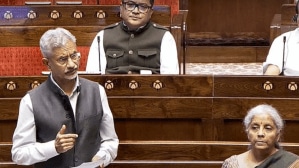‘They’ve dumped us here, how will we survive?’: What Delhi’s bulldozers left behind — broken lives, bitter politics
Development or displacement? This question lies at the heart of a wave of slum demolitions in Delhi. The Indian Express revisits key sites where homes were razed, speaking to families and politicians across parties to unpack the ongoing debate
 View of the Bhoomihin camp, in Kalkaji, New Delhi a demolished slum cluster, where residents scavenge bricks from their homes to be ferried and sold in Noida on Thursday (Express Tashi Tobgyal)
View of the Bhoomihin camp, in Kalkaji, New Delhi a demolished slum cluster, where residents scavenge bricks from their homes to be ferried and sold in Noida on Thursday (Express Tashi Tobgyal)Perima stands outside the gate of a building in Sector G7, Narela’s Pocket 4, packing sambar and chutney and arranging them on a plastic plate atop her pushcart. She wants to have everything ready — in case a customer shows up — so she doesn’t waste time packing the order later.
She stays in the flats behind her, provided by the Delhi Development Authority (DDA).
But the home where she’s lived since she was a child is 50-odd km away, at Madrasi Camp in Jangpura — now a mass of rubble. The colony was razed on June 1 after the Delhi High Court ordered the demolition of over 300 houses to clear the blocked Barapullah drain ahead of the monsoon.
Like this slum cluster, several of the Capital’s densely populated informal settlements — Bhoomiheen Camp, Taimoor Nagar, and Jailerwala Bagh — have been razed over the last two months. While the courts and authorities cite encroachment on government land, those displaced — many of them work as daily-wage workers or house help — say they are being uprooted not just from their homes, but also from their livelihoods.
Perima says she arrived at the flats in the Northwest Delhi suburb on the night of the demolition and set up the cart just three days ago. “Yesterday, it took me six hours to make the chutney because I had to travel to Jangpura to get the right chana dal. Here, there are no provision stores,” she says.
At Jangpura, she used to work as a domestic house help in four homes.
“Yahan par laake daal diya, ab kaise guzaara karein, samajh hi nahi aa raha hai, har cheez mehengi hai yahan. (They have brought us here, how we will survive, we don’t know. Everything is expensive here.) I used to earn Rs 20,000, but now I hardly earn anything. My husband also lost his job as a sweeper at Nizamuddin Railway station,” she says, while packing six idlis for her first customer of the day — at five in the evening.
Perima and her family are not the only ones who have shifted to Narela.

Ulaga Nandan (39), who also worked as a sweeper at the station but has been unemployed for a month, moved to a 1-BHK flat with his wife and two children.
“I’m worried about my children’s education; they don’t understand Hindi. If the school (Delhi Tamil Education Association Senior Secondary School in Lodhi Estate) decides to send buses here, only then can we send them; Otherwise, I’ll send them to Chennai,” he says.
Nandan spent around Rs 18,000 to furnish his 1-BHK flat in Narela. “The expenses don’t stop… every day, we have to buy water to drink… the officials say they will give us water and electricity connections, but nobody has received it to date,” he says, while pointing to the broken tiles of his washroom floor.
In the society’s complaints register, The Indian Express found 30 entries — ranging from broken washroom windows and missing taps to lack of water connections, no electricity meters, waterlogged kitchen sinks, clogged washrooms, leaking pipes, and broken tiles.
Even though 215 families were found eligible to shift to Narela, only a few have made the move. “If I don’t find a job by the end of this month, I’ll rent a room in Jangpura again,” says Nandan.
Back at the Madrasi Camp, Perumal sits on his rickshaw cart. His family is among over 155 who were not found eligible for rehabilitation. “I have sent my family back to Chennai. I can’t afford a house here. I do odd jobs during the day and sleep wherever I find a place at night,“ he says.
He claims he was falsely left out of the flat allotment list, despite having all the required documents. “Officials say they allotted a flat to someone else on my survey number. I have made multiple rounds to the office,” he says while scrolling through the documents on his phone.
At the site, the jhuggis are all gone. There are just four earthmovers working to clear the drain.
After the slum cluster was demolished, Tamil Nadu Chief Minister M K Stalin, in a letter dated June 10 to Delhi CM Rekha Gupta, urged the government to provide basic amenities to those displaced.
According to officials at the Tamil Nadu House, the state government announced relief packages of Rs 4,000 to the families. “Out of the 370 displaced families, 90 are yet to claim the amount. They have been displaced to various places, and efforts are on to trace them,” an official says.
Ten days later, and 9 km from Jangpura, Bhoomiheen camp was demolished with over 344 houses razed.
The demolished houses are now reduced to a large patch of uneven land with bricks. Some children fly kites, while others sit on abandoned sofa sets, taking care of their younger siblings while their parents are busy collecting bricks to sell.
Muhammad Anees (25), a former resident, says, “I come here with my family at 4 am and stay until noon before returning to our rented room nearby.”
He is sitting with his wife and son inside a makeshift bamboo tent. The floor is made from old wooden doors salvaged from homes, and an AAP flag is used to secure the structure. “We supported the AAP this election, but the BJP won. We were happy with the previous government,” he says.
On June 6, while deciding pleas by as many as 417 residents of the Bhoomiheen Camp in Kalkaji, the HC had denied relief to over 350 slum dwellers, stating that “encroachers cannot claim the right to continue occupying public land, pending the resolution of their rehabilitation claims under the applicable policy, as this would unduly impede public projects”.
“The police officers knocked on the doors at 3 am, when we were sleeping on our terrace. They had made announcements a day earlier to vacate the houses; they told me I didn’t have the required documents,” Anees says.
 Madrasi Camp
Madrasi Camp
A resident of Prayagraj, he was once a rickshaw driver. To be able to make rent, he now collects and sells bricks from the demolished site for Rs 2. “Jin jinko mila nahi hai, sab utha rahe hai, kuch toh kama lenge (Those who have not got flats, they are collecting bricks to earn some money),” he adds.
A few metres away is Asha Kiran Apartments, where a few eligible people were allotted flats by the DDA.
Naresh Rawat (45), a gardener who grew up in the slum, sits with his group of friends on the newly erected benches in the evening. He shifted to the flat two years back and is happy with his new address.
“Some people shifted a few years ago, while others stayed back post the court’s stay order. The authorities showed us the flat options, and our opinion was taken into consideration before finalising these. When my number came in the draw, I got the flat,” Rawat says, adding that they get 24×7 running water.
Earlier, on May 6, on the HC’s directions, the DDA demolished over 100 structures on the banks of the Taimoor Nagar drain. When The Indian Express visited the site on June 24, a heavy police force was deployed while the earthmovers continued to raze homes.
Owners of the homes could not be contacted.
According to a policeman at the site, the demolition will be completed by July 7.
The DDA refused to respond to multiple queries sent by The Indian Express about future projects and demolitions.
The most prominent site over which the threat of eviction now looms is Batla House, Jamia Nagar, where both the UP Irrigation Department and DDA claim structures have been built on their land.
According to a list compiled by Basti Suraksha Manch, an organisation advocating for housing rights of slum dwellers in Delhi, many more demolitions have been taking place at an accelerated pace in recent months.
“Since coming to power, the BJP government demolished around 30-40 slums. Currently, there are 5-10 settlements under threat of demolition. The government had given a slogan of ‘Jahaan Jhuggi Wahin Makaan’, but, instead, the poor are being removed from their homes,” says Neelesh Kumar, a social activist and member of the group.
The politics
For long, slum demolitions in Delhi have been sites of political contestation.
Once bastions of the Aam Aadmi Party (AAP), a relationship fortified by years of free water, electricity, and basic healthcare, the Capital’s 675 jhuggi-jhopri clusters saw a significant percentage of voters shift loyalties in the 2025 Assembly elections.
In the run-up to the polls, permanent housing for economically weaker sections had emerged as a flashpoint. The AAP repeatedly warned that if elected, the Bharatiya Janata Party (BJP) would roll back subsidies and initiate slum clearances. The BJP, however, had launched an aggressive counter-campaign: a “Jhuggi Ratri Pravas Samvad Abhiyaan”.
 Muhammad Anees (25), a former resident, says, “I come here with my family at 4 am and stay until noon before returning to our rented room nearby”
Muhammad Anees (25), a former resident, says, “I come here with my family at 4 am and stay until noon before returning to our rented room nearby”
As early as November 2024, more than four months before the elections, the party’s seven MPs, eight MLAs, and many other known faces had spent nights in slum clusters across the city. At the heart of this outreach was Prime Minister Narendra Modi’s slogan: “Jahan jhuggi, wahan makaan” — a commitment to ensuring housing without displacement.
The messaging struck a chord, particularly as AAP’s credibility took a hit following allegations of corruption, and the BJP came to power.
In two months, the bulldozers rolled in — and the political sparring resumed.
Earlier this month, during the Bhoomiheen Camp demolition, former CM and current Leader of Opposition Atishi alleged she was detained from her own constituency while visiting the jhuggi dwellers.
“This is not just about demolitions,” she had told reporters as police bundled her into a van. “This is about silencing the poor. BJP, Rekha Gupta ji, the very people whose homes you are destroying will be your undoing.”
CM Rekha Gupta had hit back, accusing AAP of theatrics. “No one is touching the slums. They are a party of liars — jumping from one drama to the next. We are following court orders. We want equal development for all.”
When asked about the demolition of slums in Delhi at the Express Adda on Thursday, where she was a guest, Gupta said, “If people are not willing to leave slums after being given a Rs 35 lakh flat in a good area, then it’s wrong. Delhi has 675 slum clusters. The previous governments, neither the Congress nor the AAP, provided houses to slum dwellers. The court has ordered people not to live on railway lines or near drains, which may lead to flooding.” Furthermore, she said that if the BJP government is demolishing slums, it is also providing new houses to people. “This is something that previous governments did not do,” she said.
 Perima outside the gate of a building in Sector G7, Narela’s Pocket 4. She is a former resident of Madrasi Camp (Express/Drishti Jain)
Perima outside the gate of a building in Sector G7, Narela’s Pocket 4. She is a former resident of Madrasi Camp (Express/Drishti Jain)
Even as the BJP insists the demolitions are in line with court orders and long-term redevelopment plans, murmurs of discomfort are beginning to surface within the party’s ranks — that the demolitions could alienate the very voter base the party recently secured.
“They could have asked the court for an extension, made attempts to arrange accommodation, and then carried out demolitions,” says a former AAP councillor, who had joined the BJP before the election, on the condition of anonymity. “Now people come to us with complaints. We say it’s the court’s order — but we have no answers on why there’s no rehabilitation in place.”
Another BJP councillor takes a different view: “Yes, some councillors are worried about managing anger in their areas. But party leaders have told us these demolitions are necessary. If we don’t execute developmental projects now, we’ll be questioned later. It’s part and parcel of being in government.”
For the AAP, it has reopened a door to a political strategy it once perfected — boots on the ground and slogan-heavy mobilisations. While senior leaders have been visiting demolition sites with media crews, party workers have been quietly visiting not just areas where demolitions have happened, but also bastis where eviction notices have been served.
On Tuesday evening, this messaging is put into action at the latest demolition site — Wazirpur jhuggi cluster.
Hours after the bulldozers turned back, the slum echoes with a chorus of quieter sounds: a child’s cries, the scraping of tin sheets being pulled from rubble, murmured conversations about rents, police, court orders and political promises.
Suddenly, former Delhi minister and current Aam Aadmi Party (AAP) Delhi state in-charge Saurabh Bharadwaj arrives, accompanied by a few aides, local party workers, and camera crews.
He approaches 11-year-old Atul, who stands atop the ruins of his home.
“Where are your parents?” he asks.
“They’ve gone to find a house on rent,” the boy replies.
Bharadwaj turns to the cameras. “These are school-going children. Their entire world existed in these small rooms. Now their parents are looking for shelter,” he says, gesturing to Atul.
He then points to the towering government housing project of Jailerwala Bagh in the distance. “Those flats were a dream shown to these people. Only 10 residents from here have reportedly been allotted homes. The BJP says they’ve rehabilitated residents, but everyone here knows that’s a lie.”
On June 29, the party will hold a mass mobilisation rally at Jantar Mantar, positioning it as both a protest and a platform to unify slum residents from across the city.
“This is a ground-up campaign,” says a senior AAP leader, “Leaflets are being distributed, local nukkad meetings have started. We’re telling people that their home could be next and that their voice belongs at Jantar Mantar.”












